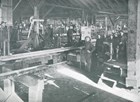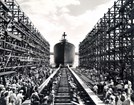Excerpted from the 2005 Cultural Landscape Report for Fort Vancouver National Historic Site, this series of articles describes the changes to and significance of the landscape at this northwest national park.
-
Fort Vancouver National Historic Site
Article 1: The Cultural Landscape of Fort Vancouver National Historic Site: Indian Country, pre-1824

Native Americans interacted with the Columbia River landscape occupied by the current Vancouver National Historic Reserve for thousands of years prior to 1824 when Governor George Simpson chose Jolie Prairie as the location for a new Hudson's Bay Company post. Read more
-
Fort Vancouver National Historic Site
Article 2: The Cultural Landscape of Fort Vancouver National Historic Site: Hudson's Bay Company, 1824-1846

Founded in 1825, Fort Vancouver became the Hudson's Bay Company Columbia Department's main supply post and administrative headquarters and the center of all HBC activities west of the Rockies, including international trade. Over the two decades, the HBC managed a fur trade business, and a massive agricultural and industrial operation. Read more
-
Fort Vancouver National Historic Site
Article 3: The Cultural Landscape of Fort Vancouver National Historic Site: Fort Vancouver and Vancouver Barracks, 1847-1860

From 1847 to 1860, the construction of the US Army's Vancouver Barracks alongside the Hudson's Bay Company's Fort Vancouver brought about tremendous changes to the landscape. Read more
-
Fort Vancouver National Historic Site
Article 4: The Cultural Landscape of Fort Vancouver National Historic Site: U.S. Army, 1861-1916

In the late 19th and early 20th centuries, soldiers from the U.S. Army's Vancouver Barracks served in conflicts throughout the American West and overseas. During this period, the post itself underwent dramatic changes that transformed it into one of the most desirable duty stations in the region. Read more
-
Fort Vancouver National Historic Site
Article 5: The Cultural Landscape of Fort Vancouver National Historic Site: U.S. Army and World War I, 1917-1918

From 1917 to 1918, Vancouver Barracks became the site of the world's largest Spruce Cut-Up Mill, designed to support the efforts of the Spruce Production Division. During World War I, this massive regional operation provided much-needed lumber for Allied aircraft manufacture. Read more
-
Fort Vancouver National Historic Site
Article 6: The Cultural Landscape of Fort Vancouver: U.S. Army and Civilian Conservation Corps, 1919-1941

Between World Wars I and II, Vancouver Barracks was the location of the regional headquarters for the Civilian Conservation Corps and was the site of an airfield in the early days of aviation. Read more
-
Fort Vancouver National Historic Site
Article 7: The Cultural Landscape of Fort Vancouver National Historic Site: U.S. Army and World War II, 1941-1947

During World War II, Vancouver became the site of the Kaiser Shipyards, an enormous complex that constructed ships for the war effort. The shipyards brought with them new jobs and the creation of new resources for its employees. Read more
-
Fort Vancouver National Historic Site
Article 8: The Cultural Landscape of Fort Vancouver National Historic Site: National Park Service, 1948-1996
Today's Fort Vancouver National Historic Site in Vancouver, Washington, and Oregon City, Oregon, tells the story of the Hudson's Bay Company's Fort Vancouver, the U.S. Army at Vancouver Barracks, early aviation at Pearson Field, and the history of the McLoughlin Family in Oregon City. Read more

